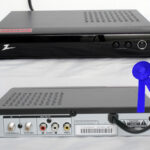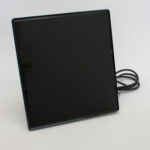If you’re trying to save money and have opted to use a DTV box to receive free, over-the-air broadcast channels, you’ve likely been faced with the prospect of having to also put up a TV antenna outside your home. Putting up an antenna is going to be very useful for receiving channels from far away or ensuring a clearer picture on your television. While putting up an antenna is not necessarily a difficult undertaking, there are a few things you should know about how to properly set up your antenna.
Installing an Antenna: A Word About Safety and Codes
Perhaps the most important thing you should always consider when putting up an antenna outside your home is to steer well clear of any overhead power lines. The utmost concern is that erecting an antenna near a power line can cause severe injury or even death to you or anyone else who is setting up the antenna or has to later adjust or work on the antenna. Whatever you do, don’t place an outdoor antenna anywhere near power lines.
Before putting up an outdoor antenna, be sure you abide all local codes and height restrictions. Many neighborhoods, towns, and cities monitor the construction of antennas and other installations that involve height or visibility issues.
Before placing an antenna in your yard, be sure you have cleared any legal obstacles that may stand in your way.
Always be sure you call 811 before you dig the hole for your antenna or anything else (including fence posts, trees, and mail boxes). This is a free service which will come to your home and check for any underground utilities before you dig.
This is a necessary step you should take. Digging without knowing what’s underground puts you and your neighborhood at extreme risk of gas line rupture, a power outage, or loss of water or sewage services.
Antenna Installation Shopping List
Once you are sure you have clearance to put up an antenna, the first step is to purchase the antenna unit right for your application. With the assumption you are building an outdoor antenna, be sure to purchase a unit that is designed to withstand outdoor elements – wind, rain, sun, and hot and cold weather.
Next, you’ll want to decide what kind of mast to purchase. After all, any antenna you buy will need to be mounted on a mast to raise it above your roofline and maximize the reception you’ll receive on your television. Aluminum piping is inexpensive and perfect for an antenna mast.
You can buy aluminum piping at your local home improvement store. If you’re going to install the mast in the ground, you’ll want to add at least three to four feet to the length of your mast to accommodate the portion of the pole that will have to go underground.
You will also need antenna cable, mounting hardware, and concrete to pour into the ground as a footer for your antenna mast; purchase at least 100 pounds of concrete.
How to Put Up an Antenna
Once you’ve finished shopping for your antenna and the necessary hardware and accessories, you’re ready to start putting up your antenna. Assuming this to be a ground-mount installation, you’ll need to first dig a hole into which you’ll place the antenna mast (and you did already call 811 and receive the green light from them on digging, right?) .
Dig a hole at least three feet deep. Four feet deep is preferable in any areas where frost and freezes occur. Mix your concrete and dump the concrete into the hole.
*You can temporarily place an upright cylinder or pipe just a little wider than the permanent antenna mast into the hole filled with wet concrete. Remove the cylinder once the concrete has set. That way, you’ll be able to form a permanent shaft in the concrete that allows for easy removal of your antenna during wind storms or for antenna repair.
Next, you’ll want to anchor the antenna to the mast. Be sure to adhere to the mounting instructions provided by the manufacturer of the antenna you purchased. Don’t make any modifications that could void the supplied warranty that comes with the antenna!
Connect all cable wiring to the antenna and be sure you have enough slack in the cable to accommodate any swinging or movement in the line due to winds as well as natural heating and cooling cycles.
Drill a hole into your house where you will insert the antenna cable into your home. While there are various ways you can seal off and protect this opening, at the very least you’ll want to apply an exterior-rated caulk around the hole to fill the gap between the wire and the rim of the hole.
Before installing the antenna mast, be sure the concrete footer has cured. Remember, a concrete footer such as the one you poured for your antenna could take up to 7 days to cure (unless you used a quick-curing concrete mix). Don’t get to hasty on installing your antenna before the footer can withstand the stress of holding the antenna mast!
A Note About Grounding Your TV Antenna
When installing any antenna outdoors, you’ll want to take the proper precautions in grounding the antenna against lightning strikes. Even if you live in an area that isn’t prone to lightning, one bolt in the wrong place is all it takes to set a house ablaze because of an improperly grounded or ungrounded antenna.
Because grounding an antenna is a very serious undertaking, it’s highly recommended you consult a skilled electrician on properly grounding your outdoor antenna.
Resources
Firsthand knowledge and experience
http://www.ehow.com/how_2141595_put-up-television-antenna.html






